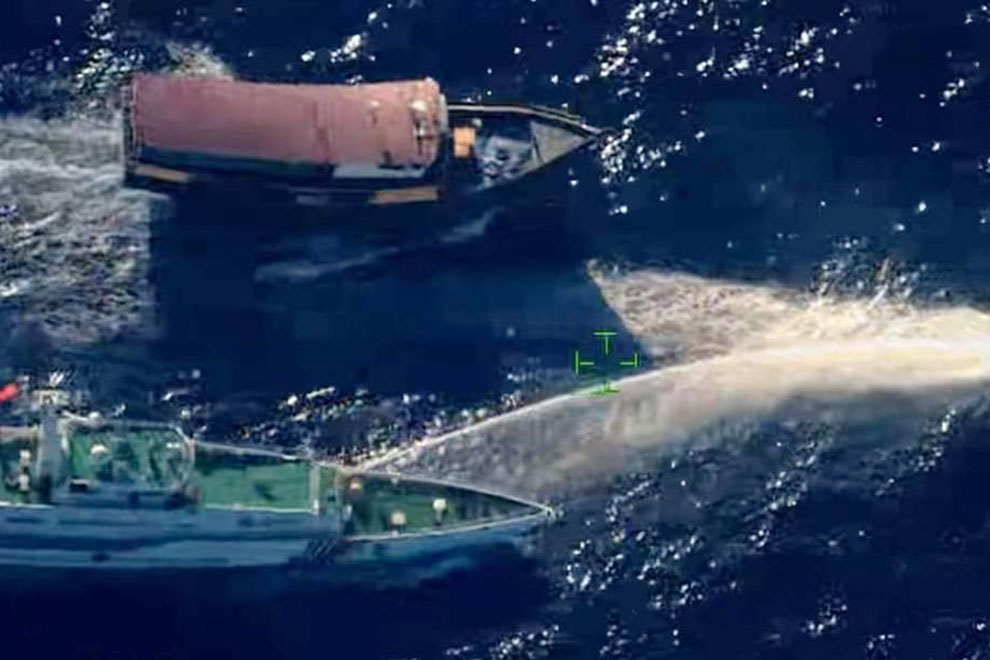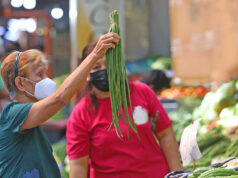4 Philippine Navy officers hurt after China fires water cannons at ship

By Kyle Aristophere T. Atienza, Reporter
AT LEAST four Philippine Navy officers were injured on Tuesday after China’s coast guard fired water cannons at one of two wooden civilian boats used in a resupply mission for Filipino troops at a remote outpost in the South China Sea.
The water cannons from two Chinese Coast Guard vessels shattered the windshield of Unaizah Mae 4, “causing minor injuries to at least four personnel on board,” the Philippines’ National Security Council (NSC) said in a statement.
The incident happened while President Ferdinand R. Marcos, Jr. was in Melbourne for a three-day summit between Australia and Southeast Asian nations. On Monday, he vowed to push back if China continues to violate Philippine sovereignty and sea rights.
The Navy officers were treated by Philippine Coast Guard (PCG) personnel from the BRP Sindangan, which was escorting the civilian boat during the mission, NSC said.
Before this, a Chinese coast guard vessel executed “dangerous maneuvers” against the escort ship, leading to a minor collision that resulted in “superficial structural damage” to the hull of the PCG vessel, it added.
It said Unaizah Mae 1, one of the two resupply boats, managed to deliver supplies to BRP Sierra Madre, a World War II-era vessel that Manila deliberately grounded at Second Thomas Shoal in 1999 to assert its sea claims.
“The systematic and consistent manner in which the People’s Republic of China carries out these illegal and irresponsible actions puts into question the sincerity of its calls for peaceful dialogue and lessening tensions,” NSC said.
The Department of Foreign Affairs (DFA) summoned the Chinese deputy chief of mission “to convey the Philippines’ protest against the aggressive actions undertaken by the China Coast Guard and Chinese maritime militia,” the agency said in a WhatsApp group message.
During the meeting, Philippine officials said China’s interference in the Philippines’ “routine and lawful activities in its own exclusive economic zone is unacceptable.” “China’s actions in Ayungin Shoal (Second Thomas Shoal) infringes upon the Philippines’ sovereign rights and jurisdiction.”
“The Philippines demands that Chinese vessels leave the vicinity of Ayungin Shoal immediately.”
Earlier in the day, the Philippine military said the resupply mission seeks to keep Philippine presence within the country’s exclusive economic zone in the South China Sea.
“It also demonstrates the Armed Forces of the Philippines’ commitment to ensuring that every Filipino will rightfully benefit from this resource-rich region.”
The Chinese Coast Guard in a statement posted on its website accused the Philippine vessels of “intrusion,” adding that BRP Sierra Madre had been “illegally grounded” at the shoal.
“The response of the China Coast Guard is in accordance with legal protocols and based on professional procedures,” it said, adding that the Philippines “broke promises, provoked with extortion tactics, sensationalized the story, and kept sabotaging the peace and stability of the South China Sea.”
The Japanese Embassy in Manila said Japan “reiterates its grave concern on the repeated dangerous actions in the South China Sea including the recent use of water cannon by the Chinese Coast Guard.”
“Japan will continue to stand with the Philippines and cooperate with like-minded countries to maintain the peace and stability in the region,” it added.
Second Thomas Shoal is just 240 kilometers west of the Philippine main island of Luzon and is nearly 900 kilometers from Hainan, the nearest major Chinese landmass.
Stanford University’s Gordian Knot Center for National Security Innovation earlier said Chinese maritime militia ships had set up “blockade positions” while the Philippine vessels were on their way to Second Thomas Shoal.
‘DANGEROUS MANEUVERS’
After the incident, Raymond M. Powell, a fellow at the Gordian Knot Center, said China “demonstrated that it is committed to violently enforcing its illegal blockade of the BRP Sierra Madre, the Philippines’ outpost for 25 years located in its own lawful exclusive economic zone.”
“There is no other place in the world where one country is conducting a blockade against another during peacetime,” he told BusinessWorld in an X message.
Mr. Powell said the outrage should serve as an opportunity for the international community to stand beside the Philippines and demand for China to “stop behaving like a pariah nation.”
European Ambassador to the Philippines Luc Veron said in an X post the “pattern of dangerous maneuvers and blocking” by Chinese vessels was troubling.
US Ambassador to the Philippines MaryKay L. Carlson condemned China’s “dangerous maneuvers,” which she said endangered lives and resulted in injuries.
The Philippine Foreign Affairs department said it had filed nine diplomatic protests against China this year, bringing the total since Mr. Marcos assumed office in July 2022 to 142.
Mr. Marcos was in Melbourne for a special summit between ASEAN and Australia, which has boosted its ties with Manila in the face of an increasingly assertive China.
The Philippine leader during a state visit to Australia last week told Australia’s Parliament Manila is on the frontline of a battle for regional peace.
Mr. Marcos on Monday told a Lowy Institute forum that while the Philippines is compelled to cooperate with China on matters where their interests align, it would “push back when our sworn principles, such as our sovereignty, sovereign rights, and our jurisdiction in the West Philippine Sea are questioned or ignored.”
“We shall never surrender even a square inch of our territory and our maritime jurisdiction,” he said.
“China sends another message of violence as the collision occurred at a time when Marcos met with Australian and Southeast Asian counterparts to lobby for the Philippines’ sovereignty and maritime rights,” said Chester B. Cabalza, founder of Manila-based International Development and Security Cooperation.
“It goes to show that Beijing detests Manila’s stronger collective deterrence and multilateral track in advocating rules-based actions in the South China Sea,” he said in a Facebook Messenger chat.
He noted that the collision on Tuesday was not the first, adding that the violence perpetrated by Chinese coast guard and maritime militia vessels had malicious intent.
The Chinese Coast Guard rammed a PCG ship and two Philippine resupply ships, one of which was carrying the Philippine military chief, in December.
Almost 200 Chinese militia ships were present near disputed areas of the South China Sea on any given day last year, or a 35% increase, US think tank Asia Maritime Transparency Initiative (AMTI) said in a report on Feb. 28.
It said the contrast between the relatively low Chinese militia presence at Second Thomas Shoal and the intensity of operations during resupply missions indicates that “professional militia ships stand ready to support China Coast Guard operations at short notice at any point of friction.”



